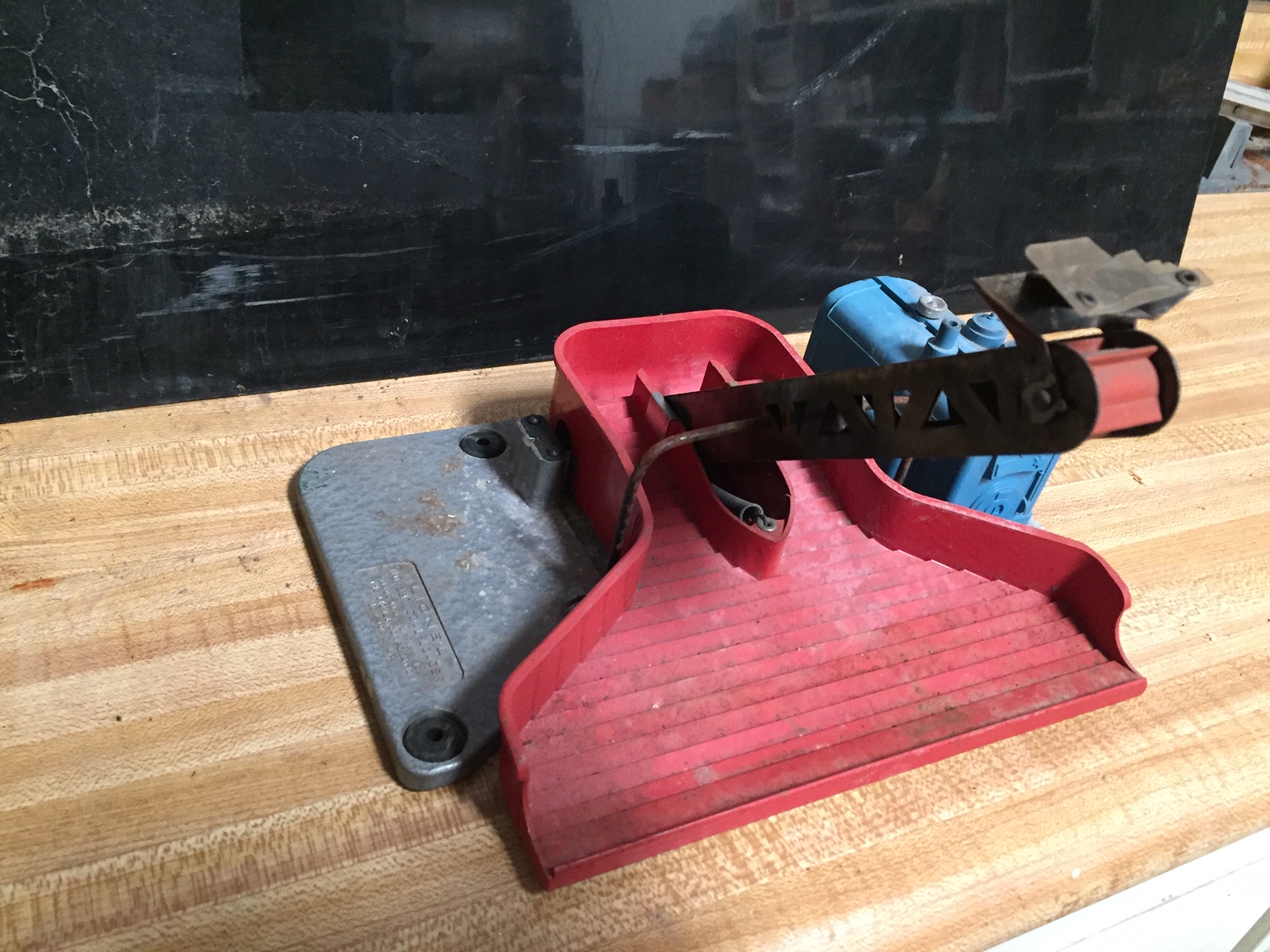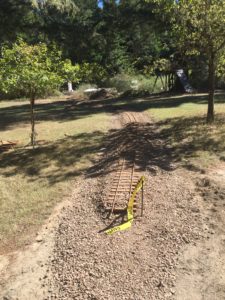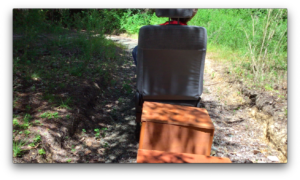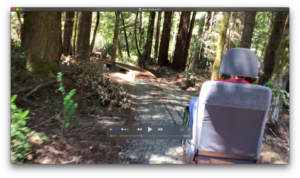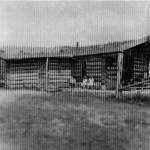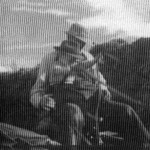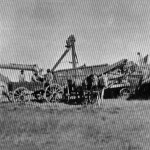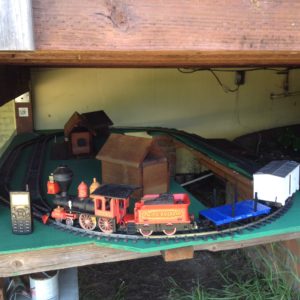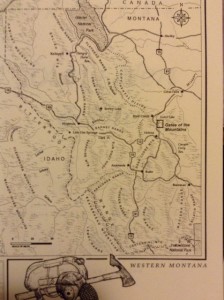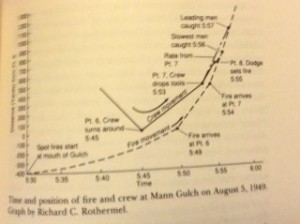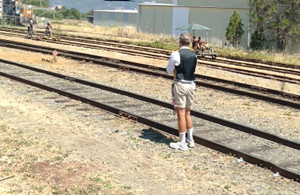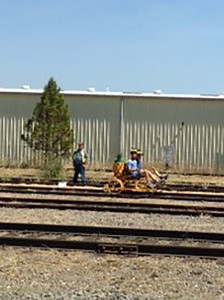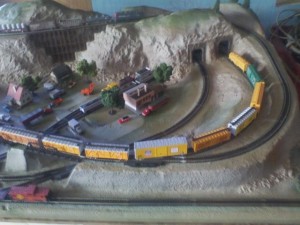Today, I’m going to describe a recent trip to Ireland. On June 5, I flew over to Ireland with my daughter, Jodie. When we got there, my other daughter, Lina had come over from her trip through Germany and joined us. The three of us spent the next ten days in Ireland. I realize that this Blog is supposed to be about trains, and my original intention was to ride on one of the restored Steam trains that run in Ireland between Dublin and Belfast. There is a wonderful event called “Steam and Ja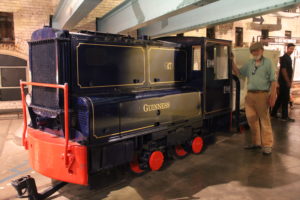 zz”, but that was scheduled for June 17, 3 days after we returned to the U.S.. Besides that, all tickets for the event were sold. So, that sounds like something to work into another trip. While at the Guiness Storerooms, there was an old engine (see Pict) used entirely within the Storeroom to move around cases of beer. They are shipping three million pints of Guiness every day all over the world! So that should count somewhat as a train.
zz”, but that was scheduled for June 17, 3 days after we returned to the U.S.. Besides that, all tickets for the event were sold. So, that sounds like something to work into another trip. While at the Guiness Storerooms, there was an old engine (see Pict) used entirely within the Storeroom to move around cases of beer. They are shipping three million pints of Guiness every day all over the world! So that should count somewhat as a train.
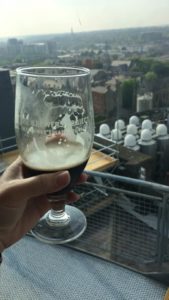 We spent our first two days in Dublin, touring around the city and surrounding areas. The Eastern coastline was spectacular and even looked like the coast line along Northern California. Some of the roads there were even like Route 1 south of Elk. We toured the Guiness Storerooms and Brewery, sampling the wares (the picture is from the Gravity Bar above the St. James Gate) and watching Irish Dancing. Four folks (two men and two women) danced in heavy shoes (clog dancing) with Brooms as partners! If that sounds easy to do, it wasn’t, they were very good! We found a lot of pubs (surprise!! ) and live music ion every night and in every town that we stopped in, so it was a most enjoyable trip.
We spent our first two days in Dublin, touring around the city and surrounding areas. The Eastern coastline was spectacular and even looked like the coast line along Northern California. Some of the roads there were even like Route 1 south of Elk. We toured the Guiness Storerooms and Brewery, sampling the wares (the picture is from the Gravity Bar above the St. James Gate) and watching Irish Dancing. Four folks (two men and two women) danced in heavy shoes (clog dancing) with Brooms as partners! If that sounds easy to do, it wasn’t, they were very good! We found a lot of pubs (surprise!! ) and live music ion every night and in every town that we stopped in, so it was a most enjoyable trip.
One other stop we made in Dublin was the 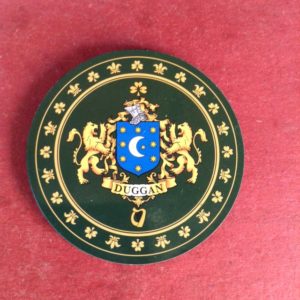 Genealogy Dept. in the Library. We found copies of the 1837 Baptismal Records from St. Peter’s Parish in Athlone, Co. Roscommon for my Great-Grandmother–Mary Anne Duggan. I had found that record on Micro-Fiche 26 years ago on my first time in Ireland. The Irish Surname Duggan is a anglicised rendering of the Gaelic surname O’Dubhagain which traces back to 5th century Irish Kings and Spainish invaders.
Genealogy Dept. in the Library. We found copies of the 1837 Baptismal Records from St. Peter’s Parish in Athlone, Co. Roscommon for my Great-Grandmother–Mary Anne Duggan. I had found that record on Micro-Fiche 26 years ago on my first time in Ireland. The Irish Surname Duggan is a anglicised rendering of the Gaelic surname O’Dubhagain which traces back to 5th century Irish Kings and Spainish invaders.
I had hoped that the records had been entered into an online database, but all that was done was pictures of the original 1837 parish books with the Latin entries which were sometimes misspelled (as often occurred).
We then rented a car and left Dublin, heading to Athlone. We were lucky and only had rain while we were driving. Arriving t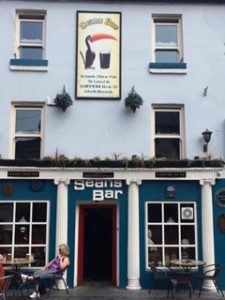 here, we first found a bar called Sean’s Bar (Interesting, because my son’s name is Sean) that is claimed to be the oldest bar in Ireland. There is a portion of the original ba
here, we first found a bar called Sean’s Bar (Interesting, because my son’s name is Sean) that is claimed to be the oldest bar in Ireland. There is a portion of the original ba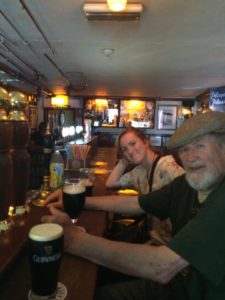 r’s wall that was built around 900 AD. After having a beverage (see picture), we then found a large church called Sts. Peter & Paul’s. After going in and marveling at the constr
r’s wall that was built around 900 AD. After having a beverage (see picture), we then found a large church called Sts. Peter & Paul’s. After going in and marveling at the constr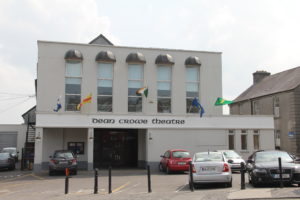 uction, we found out that it was built in 1937. we finally located the original St. Peter’s after a few inquiries, it is now a movie theatre called Dean Crowes. We went to a local library to see if there were more records for my great-grandmother’s family, but the Genealogy person was on vacation. We have his Email address and a sheet showing what additional records he can search. Since the only dates we have are her Baptism and then, her marriage to my Great-Grandfather in Iowa in 1859, there’s a big gap and lots of questions concerning their life in Co. Roscommon and their trip to the United States. Maybe we’ll find out some more via Email. I’ll probably do another post with more on the family history, if there’s interest.
uction, we found out that it was built in 1937. we finally located the original St. Peter’s after a few inquiries, it is now a movie theatre called Dean Crowes. We went to a local library to see if there were more records for my great-grandmother’s family, but the Genealogy person was on vacation. We have his Email address and a sheet showing what additional records he can search. Since the only dates we have are her Baptism and then, her marriage to my Great-Grandfather in Iowa in 1859, there’s a big gap and lots of questions concerning their life in Co. Roscommon and their trip to the United States. Maybe we’ll find out some more via Email. I’ll probably do another post with more on the family history, if there’s interest.
We then headed to Galway and then over to the Arion Islands that were off the coast in the Atlantic Ocean. After riding in a horse and buggy around the largest island, we went back to the Cliffs of 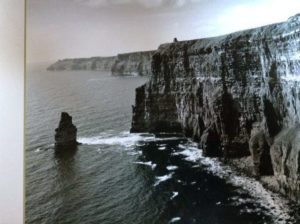 Moher. I got a large picture of the Cliffs, here is a reduced picture (to fit in this blog) The black and white coloring doesn’t do justice to the actual shades of color of the Cliffs. The signal towers (the second one can be seen in the middle of the picture, the first is at the furtherest South end of the Cliffs) were used in the early 1800s to alert the British fleet when Napoleon’s fleet were sailing to attack Britian. Signals (probably latterns) were flashed from one tower to the next.
Moher. I got a large picture of the Cliffs, here is a reduced picture (to fit in this blog) The black and white coloring doesn’t do justice to the actual shades of color of the Cliffs. The signal towers (the second one can be seen in the middle of the picture, the first is at the furtherest South end of the Cliffs) were used in the early 1800s to alert the British fleet when Napoleon’s fleet were sailing to attack Britian. Signals (probably latterns) were flashed from one tower to the next.
We stayed at a B&B, the Carrig House, in Co. Clare. Maurice and Shirley Glennon were our hosts, and they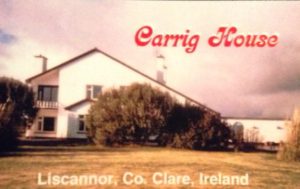 treated us grandly and told us a number of stories, including some
treated us grandly and told us a number of stories, including some about John Holland, who designed prototypes and models that were the basis for modern submarines including the atomic-powered ballistic ones. He died in 1914 without much recognition from the U.S. Government for his work (that came later, at least in Ireland). The Carrigs, then cooked a wonderful Irish breakfast for us that kept us in good spirits as we traveled on to places they recommended. I don’t know how the Irish keep trim if they eat that kind of breakfast every morning. It must be a little Leprechaun magic that keeps everyone fit and trim, or maybe all the dancing!
about John Holland, who designed prototypes and models that were the basis for modern submarines including the atomic-powered ballistic ones. He died in 1914 without much recognition from the U.S. Government for his work (that came later, at least in Ireland). The Carrigs, then cooked a wonderful Irish breakfast for us that kept us in good spirits as we traveled on to places they recommended. I don’t know how the Irish keep trim if they eat that kind of breakfast every morning. It must be a little Leprechaun magic that keeps everyone fit and trim, or maybe all the dancing!
We then went around the “Ring Of Kerry”, a roadway that circles around a large bay in Co. Kerry. There were rural greenery, many great beaches, old castles and lovely towns. We stayed in Waterville at a B&B which turned out to be hosting a High School Football (Soccer to us Americans) Tournament that honored the 80th birthday of the “Willie Mays” of Irish Football, Mick O’Dwyer. Later that evening, there was a huge fireworks display that lit up the whole village and lasted for over 30 minutes!
Finally we had to go back to Dublin to catch our plane back to the U. S., but not before we went to a pub for the Irish-Sweden Football match. The huge room was packed with folks singing, dancing and cheering! And they started 2 1/2 hours before the game started. The game ended in a tie 1 to 1, (Ireland scored both, an “Own Goal” for Sweden), which was fortunate, otherwise we probably wouldn’t have been able to leave.
A long trip back, but plenty of memories. There a lot we did, but it seemed like we didn’t do enough which means I need to go back, hopefully sooner than 26 years!

